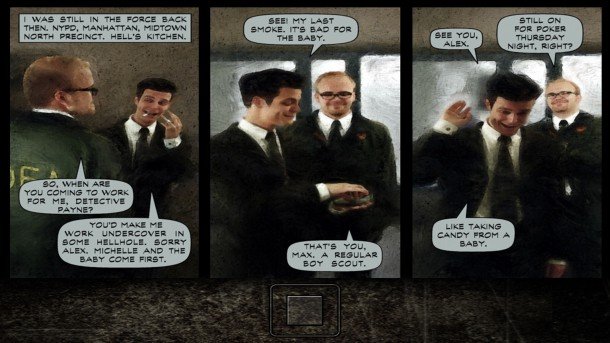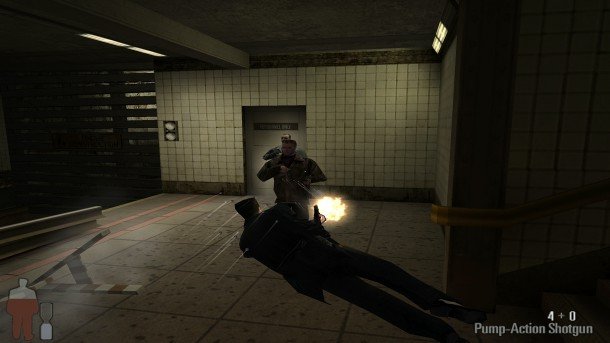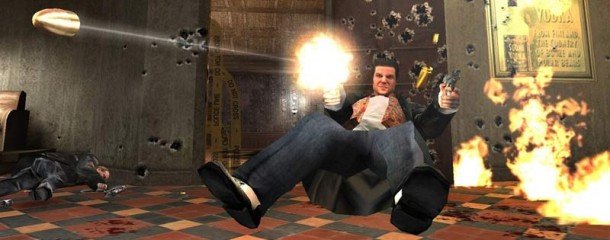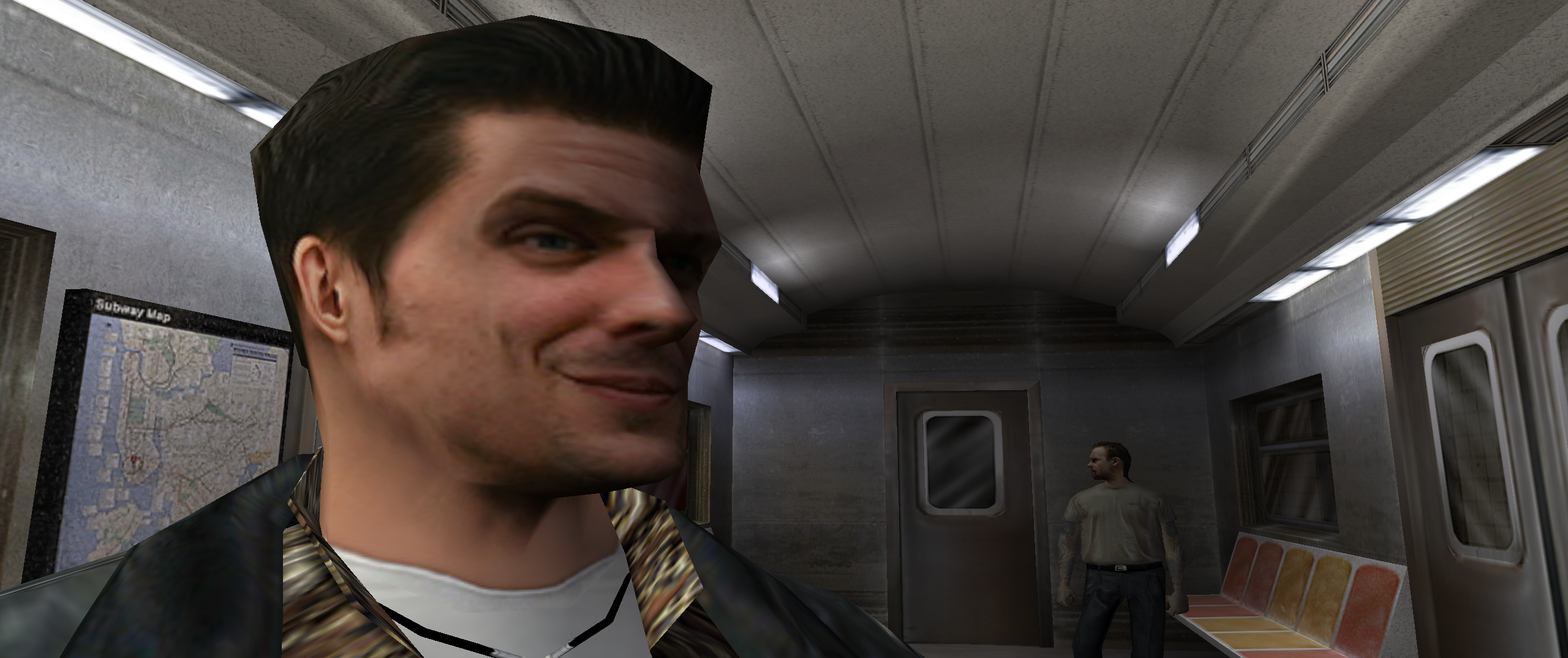Our Verdict
Great third-person actionthe mind-blowing graphics are worth every cent.
PC Gamer's got your back
Tyler Wilde provides commentary followed by the full, original text of our Max Payne review from the October 2001 issue of PC Gamer US.
I played Max Payne again recently, and it's still great. It also looks really, really goofy: it's a lot funnier now than it was then to see Sam Lake's grimace plastered onto Max's head as he shoot dodges face first into goons. Max isn't quite "cutting-edge" anymore, I'm afraid, and looking at the graphic novel bits again reminds me that a lot of the panels look like photographs slathered with Photoshop filters.
But Max Payne is still great. It might not "have bystanders gawking over your shoulder in amazement," but I think this review holds up otherwise. If you've never played it, though, I'd suggest waiting for a Steam sale to bring it down from $10/£6—I have to admit that my recommendation is at least partially rooted in nostalgia for one of my favorite series.
***
Max Payne review
Your ticket to the longest, best-directed action movie you've ever played
Required: PII 450, 96MB RAM, 800MB HD, 16MB 3D card
We recommend: PIII 700, 128MB RAM, 32MB 3D card
The last game we saw from Finnish developer Remedy Entertainment was in late 1996, when they released a top-down racer called Death Rally. Heard of it? Probably not. The game fell under the radar but became a grass-roots success among web junkies who played the shareware version, and when Remedy began work on a high-technology action game called Max Payne in 1997, a lot of folks started paying attention.
Nearly four years later, after volumes of press attention (including our May 2001 cover), Max Payne went gold on Sunday, July 16. Having played through it, we can finally declare it was worth the wait. Max Payne is great. Truth be told, third-person shooters don't come any better.
So far, since little was known about the storyline, the attention surrounding Max Payne has focused on the game engine. Fortunately, the plot—a grim, compelling noir-style cop tale—is as gripping as the stunning action sequences.

The game opens with Max teetering on the roof of a New York skyscraper, snow falling “like ashes from post-apocalyptic skies,” sirens blaring from the street below. He begins to reflect on his situation, and the ensuing game is a 21-chapter narrated flashback of how he got there.
In the first five minutes of gameplay, you relive the morbid nucleus of Max's rage. Returning home from your police beat, you find your adored wife and baby brutally slain, and the drugged-up killers still roaming the house. After dispatching them, Max joins the DEA, seeking revenge on the drug pushers responsible.
We flash forward to sometime a few days ago. Max has infiltrated the toughest mob family in New York, and is on his way to meet with his DEA handler in a subway station when everything goes horribly awry. Max's cover is blown, his partner is killed, and Max is framed for his murder. Left with nothing to lose and a swelling ache for vengeance, he proceeds to hunt the mobster chain of command.
We already knew that the game engine employs a slow-motion “bullet-time” mode in which action is played out like scenes from The Matrix, but we didn't know how it improved the mechanics of the game. It turns out that bullet-time is a resource, akin to ammunition and health, that slowly recharges with each kill. It's useful because Max, unlike most FPS heroes, doesn't have bulletproof skin. You take damage just as easily as your enemies, so bullet-time is the player's edge.
When in slow motion, you can turn and aim just like normal (though firing speed is diminished). This allows you to get a precise bead on enemies instead of just firing blindly in their direction. Using bullet-time in conjunction with a falling leap makes you a difficult target, and Max can generally take out three enemies with only minor injuries.

Oh, and we should probably tell you that it's the best-looking effect since the invention of the polygon. You don't just jump between regular-speed and slow-motion; a “tweening” effect creates a smooth transition between tempos. Gun-barrel explosions are full-bodied, bullets leave trails as they glide past your head, and shells eject from chambers as if in zero gravity. Every noise sounds like a 45 played at 33, including voices and ricocheting bullets. It's mesmerizing, and will have bystanders gawking over your shoulder in amazement.
When you're not in-game, engaged in an action scene straight out of a John Woo–directed slugfest, the story unfolds through a distinct graphic novel. Whenever you answer a phone, read a note, talk to someone, or travel between sites, comic panels pop up with sound effects and narration. It works well, allowing you to relax and watch some artful exposition after a hard hour of fighting. The shadowy drawings help flesh out the film-noir ambience Remedy was aiming for.
The in-game environments are less stylized and more realistic, with certain scenes breaching the photo-realism barrier. The texture work has to be seen to be believed. A detailed, seamlessly mapped, high-resolution photograph covers every 3D model, from people to pistols to store fronts. Amazingly, the game doesn't require a ninja system. It runs smoothly on a Pentium 500, due in part to the Finns' uncanny appreciation for tight code.
The fire effect deserves particular mention. I have never, in two decades of gaming, seen flame so believably rendered in real time. From candlesticks to muzzle flash, it moves like the real thing. One mission has you racing through a restaurant exploding in flames, and if you're not blind, your jaw will drop.
The game dynamically adjusts enemy skill level to suit your reflexes, a cool and invisible trick. The thugs make for decent opposition, but their strength is their brawn, not intelligence. The AI can get stuck firing into walls or beams, leaving Max enough time for a picnic before silencing them. They're all pretty much the same in terms of abilities, and there are no thrilling boss characters.
With the exception of two nightmarish dream sequences (which you actually play through, making for some disturbing side trips into hell), missions take you on solo guns-blaring tours of city buildings and, in one case, a cargo ship. The result is an endless stream of cool action scenes, but missions might have been more interesting with the addition of friendly AI. Throughout the game, you commission someone to unlock a door three times. Besides that, you're on your own.

There are also no innocents in the game—only gangsters and druggies. This absence is explained by the snowstorm, which has everyone boarded up at home, but the city that never sleeps seems strangely dormant.
The lack of multiplay isn't so much an issue these days, as single-player games seem to be experiencing a healthy resurgence. I'm not even sure how it would be possible to implement deathmatch with the problem of bullet-time, so don't expect any such option here. You'll just have to settle for a sweet single-player story.
One last point of praise Remedy deserves is for the load times. Loading a map the first time takes several seconds, but anytime after that (such as hitting the quickload key after a pathetic dive into a shotgun blast), it's instantaneous. Finns are obviously very impatient.
If you're looking for a great thrill ride, an interesting story, and bleeding-edge technology, Max Payne delivers all of them. As with any engine's first title, its potential is not totally fulfilled, but the graphical novelties outweigh any shortcomings. Fans are already setting to work on modifying their own Max Payne total conversions. We're dying to see what comes next. — Jeremy Williams
Highs: A new high bar for incredible visuals; intricate story; great load times
Lows: Unrefined AI; not much variety in mission objectives or enemy tactics.
Great third-person actionthe mind-blowing graphics are worth every cent.
PC Gamer is the global authority on PC games—starting in 1993 with the magazine, and then in 2010 with this website you're currently reading. We have writers across the US, Canada, UK and Australia, who you can read about here.



